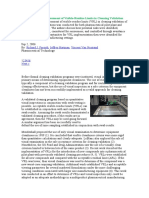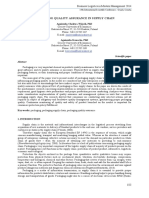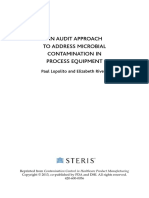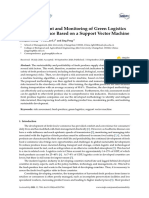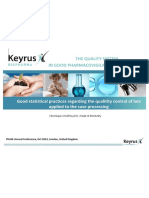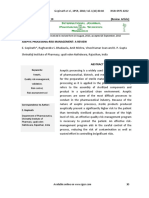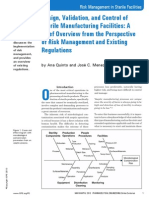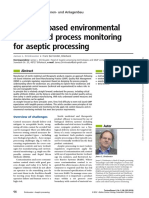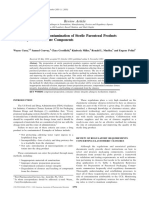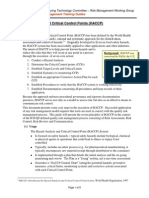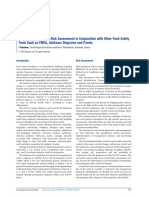Professional Documents
Culture Documents
Options For Prevention of Product CrossContamination in Logistic Processes
Original Title
Copyright
Available Formats
Share this document
Did you find this document useful?
Is this content inappropriate?
Report this DocumentCopyright:
Available Formats
Options For Prevention of Product CrossContamination in Logistic Processes
Copyright:
Available Formats
Volume 6, Issue 7, July – 2021 International Journal of Innovative Science and Research Technology
ISSN No:-2456-2165
Options for Prevention of Product Cross-
Contamination in Logistic Processes
Marieta Stefanova
Department of Management and Logistics,
Naval Academy “N. Y. Vaptsarov”,
Varna, Bulgaria,
Abstract:- Over the past few years there have been These two methods can be fulfilled by applying an integrated
frequent cases of cross-contamination within the logistics management system and by using it for effective management
supply chains. This paper examines the options for of the processes [15, 16].
preventing cross-contamination by the application of an The purpose of this study is to ensure the reduction,
integrated product quality and safety system. An analysis prevention or elimination of the food safety risks as a means to
of the factors contributing to the prevention or protect consumers by applying a cross-contamination risk
minimisation of the risk of cross-contamination is management model in logistics organisations.
presented. The application of the method allows
assessment of the risk of cross-contamination by II. METHODS
identifying the probability of each hazard, its severity and
the likelihood of detecting it before the product reaches The 11-step model (presented in figure 1) was applied in
the consumer. It has been concluded that despite the this study for identification, prevention and reduction of all
numerous risks of cross-contamination in the logistics significant risks of cross-contamination in logistics
chain, the introduction of a quality management system organisations. The model was used as part of the quality and
has the potential to minimise this risk. safety management system in the companies where it was
applied. The analysis based on the model indicated on figure 1
Keywords:- Logistical Processes, Cross-Contamination. was applied in 5 logistics organisations. Significant risks were
defined as the risks that could adversely impact the systems
I. INTRODUCTION and are very likely to result in an overall failure of the system.
The application of the model took place based on the
Over the past few years the cases of product withdrawals following key stages:
and recalls from the retail chains and the end users have Formation of a team of experts for introduction of the
become more frequent as a result of detected cross- model;
contamination [1, 2, 3, 4, 5], the highest risk being the one Analysing the existing risk management system in the
related to cross-contamination with allergens [6, 7]. This studied logistical processes;
implies the need to seek further means for prevention, Dividing the system into subprocesses, constituents and
reduction or elimination of the risks of cross-contamination in stages of the processes related to unpacking, packaging,
the logistics chain. The purpose of the introduction of wrapping or repackaging of the products;
integrated management systems is to control the risks Identification of the primary and secondary functions of
associated with food safety and quality by helping identify and each process and identification of the possible risks;
manage them through the introduction of adequate control Application of the 11-step model;
during each step of the processes that are part of the food Second analysis of each of the indicated stages of the
chain. model;
Identification of the planned measures in the model for
There are two ways to seek prevention of cross- compensating and preventing the risks.
contamination in the logistics chain. One of them is to ensure
the introduction of a procedure for controlling the more
accurate product label declaration of ingredients [8, 9] that
could be present as a result of cross-contamination in the
logistics chain, so that those suffering from allergies could
avoid the relevant food products [10, 11]. The second way is
through the application of a product quality and safety
management system to exercise effective control [12, 13] in
order to ensure that when the occurrence of a specific
contaminant due to negligence can be identified in case of
cross-contamination, its amount in the product is not in levels
that would create a risk for people suffering from allergies and
that the product will be safe for human consumption [14].
IJISRT21JUL1198 www.ijisrt.com 1162
Volume 6, Issue 7, July – 2021 International Journal of Innovative Science and Research Technology
ISSN No:-2456-2165
III. RESULTS
1. Existing cross-contamination risk management system
The elimination of all possible risks of product cross-
contamination in the logistics chain is virtually impossible due
to the wide variety of products handled in this chain. The
possible effects can be sought in the reduction of the risks and
2. Identification of a list of input commodities and materials that are minimising their impact through an analysis that is adequate to
subject to repackaging and relabelling in the logistics organisation. the actual situation and effective management of the logistics
processes. The most significant risks of cross-contamination in
the chain are associated with the reverse logistics, when
consumers or customers return the goods that had already been
3. Identification of the suppliers of the input commodities and delivered to the logistics warehouse for some reason. The
materials mentioned in point 2. cross-contamination management model was applied as a
series of 11 steps (figure 1), starting with the identification of
inputs and products containing ingredients that pose risk of
cross-contamination (allergens, microbiological
4. Identification of the end products that were repackaged, finished contamination, etc.), identification of the risks based on the
with additional packaging and returned after claims from customers. actual conditions in the logistics warehouses and the
implemented processes and defining appropriate control
measures for the actual conditions in the logistics warehouse
to be set in the process management programmes as part of the
5. Analysis and verification of the process flow and the possibilities quality management system. These stages are detailed in the
for cross-contamination. next part of the paper.
A. Analysis of the existing cross-contamination risk
management system
The logistics organisations examined in this paper have
6. Analysis of the risk of cross-contamination in the logistics chain.
cross-contamination risk management procedures in place.
The introduced procedures allow a certain level of control on
the probability of accidental or deliberate product
contamination. The risk from the processes associated with
7. Creation and introduction of a procedure for prevention of cross- reverse logistics was not assessed in any of the studied
contamination during repackaging. companies.
B. Identification of a list of input commodities and materials
that are subject to repackaging and relabelling in the
8. Staff training for prevention, elimination or minimisation of the logistics organisation
risk. This stage involves creation of a list of all input and
output products for each individual logistics warehouse. The
list should be completed with all used inputs and materials that
could cause cross-contamination. There should be a focus on
the products with complex composition that could also be used
9. Control on the processes introduced.
as ingredients in the packaging and repackaging of the
products. After the creation of the list, the collected
information was analysed and summarised in a special form
created for this purpose.
10. Validation and verification of the process management.
C. Identification of the suppliers of the input commodities
and materials mentioned in point B
During this step all suppliers of input commodities and
materials were identified. The risk was analysed with focus on
the goods exposed to a higher risk of cross-contamination with
End of process
the suppliers. Attention was paid both on the possible
omissions in the labelling of the goods and on the possible
Cross-contamination risk management model during
Fig. 1. risks of deliberate or unintentional cross-contamination. The
the packaging and repackaging of products in the logistics team conducting the analysis reached to a consensus on the
companies. (Source: Own research) clear distinction between high-risk and low-risk products. The
possible decisions with respect to high-risk products that
should be taken were identified as follows:
IJISRT21JUL1198 www.ijisrt.com 1163
Volume 6, Issue 7, July – 2021 International Journal of Innovative Science and Research Technology
ISSN No:-2456-2165
Effective auditing on the supplier and undertaking plans F. Assessment and analysis of the risk of cross-
for corrective actions in case of established non- contamination in the logistics chain
conformities during the audit; This stage involved a risk assessment. During the
Appropriate labelling of the products with signs and analysis all goods were divided into three groups based on the
symbols to inform the consumer about the possible risks of assessment given by the experts and the consensus reached
cross-contamination; between them.
Implementing steps for minimising the risk of Products with a very low risk class that should be managed
contamination in the new supplier selection procedure. by using the introduced customary control measures.
Products with a moderate risk class that should be
D. Identification of the end products that were repackaged, managed by using the operational programmes for
finished with additional packaging and returned after claims management of the specific risk and the relevant control
from customers. measures.
During this step of the process all end products exposed Products with a significant risk of contamination that
to a risk of cross-contamination were identified. After the should be managed by introducing plans for control of
identification a list was created summarising the details about cross-contamination. These products could be potentially
the possible potential and actual risk of contamination of the contaminated with other products, the staff protective
finished products. The focus was on the products that were clothing, by dispersing and spilling liquids and powder
part of the processes implemented in the warehouse for mixtures or as a result of inadequate cleaning.
packaging, repackaging and products returned by customers
after claims. G. Creation and introduction of a programme for prevention
of cross-contamination during repackaging
E. Analysis and verification of the process flow and the The cross-contamination risk management programme
possibilities for cross-contamination. introduced in the logistics also involved measures for
This stage included confirmation of the place of the protecting the products handled. There were numerous rules in
process flows of inputs and materials in the logistics this programme, with the most important of them being:
warehouse from the moment of receiving the inputs and goods To clean and disinfect the warehouse premises, the staff
to the time of shipping the finished product to the customer, as changing rooms and the equipment immediately after
well as the warehousing of the products returned by the handling high-risk products and after the end of the
customers. All process stages with identified high risk of warehouse working day, if possible;
cross-contamination were considered in detail and all the To avoid the temporary storage of unpacked products in
necessary subprocesses and operations were identified to bulk or in a liquid state;
allow analysis of all secondary activities: To introduce zoning between high-risk and low-risk
Inputs used by the goods suppliers which could products, as well as clear identification of these zones and
contaminate the supplied products; the relevant warning pictograms;
The processes for procurement of goods and the To designate a zone in the warehouse for storage of
possibilities for cross-contamination of flows during the products returned after claims, which should be physically
implementation of operations that are exceptional and not distant from the zone of the high-risk products that are
foreseen in the routine operation of the warehouse; subject to packaging and repackaging;
The processes of storing inputs and products where To prevent the simultaneous packing and unpacking
incorrect storage compatibility is possible during periods operations of two high-risk products of different
of peak overloading of the warehouse premises; composition and type;
The processes of handling the goods in case of damage of To make a distinction between zones for high-risk products
the warehouse equipment; and zones for cleaning and disinfection chemicals;
Storage of the materials used during the packaging and To exercise appropriate effective control to ensure that the
repackaging of the product; waste from the packages of the unpacked products will not
The processes of temporary storage and handling of the create conditions for cross-contamination;
intermediary product; To minimise any unnecessary movement of equipment,
The presence of persons external to the organisation in the inputs and materials.
warehouse who are servicing or handling the product;
Rules for wearing protective clothing by the warehouse H. Staff training for prevention, elimination or minimisation
staff; of the risk
The processes related to cleaning and disinfection of the The necessary trainings for preventing cross-
warehouse premises; contamination in the logistics operations should cover the
The processes of management of products that are not fit entire staff present, including the temporarily hired warehouse
for consumption, products past their expiration date and workers. Training is the most appropriate method for
waste during the operational work; familiarising the staff with the newly introduced programmes
for risk management and risk minimisation and mitigation to
acceptable levels.
IJISRT21JUL1198 www.ijisrt.com 1164
Volume 6, Issue 7, July – 2021 International Journal of Innovative Science and Research Technology
ISSN No:-2456-2165
I. Control on the processes introduced REFERENCES
Control should be exercised with the necessary
frequency based on the conditions and risks for the respective [1] K. Supian, "Cross-contamination in processing,
logistics warehouse. Exercising effective control should be packaging, storage, and transport in halal supply chain,"
followed by verification in records and documents by the in In Preparation and Processing of Religious and
person who exercised control. This will allow the person Cultural Foods, London, Woodhead Publishing, 2018,
authorised by the management to verify the quality and safety pp. 309-321.
of the product before it leaves the warehouses for marketing in
the retail network.
[2] P. Farage, Z. R. Puppin, V. Cortez, L. Gandolfi and E.
Yoshio, "Gluten-free diet: From development to
J. Validation and verification of cross-contamination risk
assessment of a check-list designed for the prevention
management in logistics
of gluten cross-contamination in food services,"
Validation was performed by collecting evidence for
Nutrients, vol. 10, no. 9, pp. 1-12, 2018.
records about the application of the risk management
procedures and programmes introduced, along with [3] J. Han, M. Zuo, W. Zhu, J. Zuo, E. Lü and Y. Xin-Ting,
verification that the measures are sufficient to control the "A comprehensive review of cold chain logistics for
hazard of cross-contamination within a certain acceptable fresh agricultural products: Current status, challenges,
level. In the course of the study, simulation and playing of and future trends," Trends in Food Science &
“the worst scenario” with respect to the studied risks was Technology, vol. 109, no. March 2021, pp. 536-551,
performed. Several products were analysed in an accredited 2021.
laboratory. The results from the analyses confirmed that the [4] S. Srivastava, A. Chaudhuri and R. Srivastava,
introduced risk management system was effective and "Propagation of risks and their impact on performance
consistent with the specific conditions for each logistics site. in fresh food retail," The International Journal of
The risk of cross-contamination should be periodically Logistics Management, vol. 26, no. 3, pp. 568-602 ,
verified on an annual basis in order to confirm whether the 2015.
applied risk management methods are relevant or changes [5] F. Schwägele, "Traceability from a European
need to be implemented. The verification confirmed that the perspective," Meat science, vol. 71 , no. 1, pp. 164-173,
consistent management of cross-contamination was effective 2005.
and provided the necessary level of efficiency. In addition to
[6] B. Remington, J. Baumert, W. Blom, G. Houben, S.
the analysis of the operations applied for verification of the
Taylor and A. Kruizinga, "Unintended allergens in
system, monitoring and measuring activities, daily visual
precautionary labelled and unlabelled products pose
control and internal and external audits by an accredited body
significant risks to UK allergic consumers," Allergy,
were performed.
vol. 70, no. 7, pp. 813-819, 2015.
IV. CONCLUSION [7] S. Sheth, S. Waserman, R. Kagan, R. Alizadehfar, M.
Primeau and S. Elliot, "Role of food labels in accidental
The prevention and minimisation of the risks of cross- exposures in food-allergic individuals in Canada,"
contamination in logistics require the introduction of policies, Annals of Allergy, Asthma & Immunology, vol. 104, no.
programmes and rules for their effective management. The 1, pp. 60-65, 2010.
main purpose of the management of these risks is to ensure the [8] J. Soon and L. Manning, "“May Contain” allergen
safety of the products in the warehouse and the products statements: Facilitating or frustrating consumers?,"
supplied to the end user. Irrespective of the introduction of Journal of Consumer Policy, vol. 40, no. 4, pp. 447-
such good logistics practices and effective control, the risk 472, 2017.
cannot be eliminated completely. An integrated approach is [9] S. Besnoff, "May Contain: Allergen Labeling
necessary, along with management of the food safety during Regulations," University of Pennsylvania Law Review,
all steps of the logistics operations management process in vol. 16, no. 6, pp. 1465-1493, 2014.
order to reduce or prevent the risks. The model presented in
[10] P. Jones, "Food safety in the spotlight," Food Australia,
this study can support the proper management of the
vol. 69, no. 5, pp. 28-30, 2017.
processes, so that the end user in the logistics chain receives
products that are safe for human consumptions and where the [11] B. Boutros, M. Hewedi, K. Roberts and F. Megahid,
cross-contamination risk is minimised. "Food safety traceability systems in the maritime
catering logistics," vol. 5, no. 15, pp. 1-9, 2014.
[12] V. Dumont and P. Delahaut, Processing of egg-free
foods, Hoboken, USA: John Wiley & Sons Inc , 2010,
pp. 259-269.
[13] E. Lippner, S. Sichere, M. Land, M. Schatz and C.
Dinakar, "Needs assessment survey for a food allergy
control tool," The Journal of Allergy and Clinical
Immunology: In Practice, vol. 7, no. 2, pp. 701-703,
2019.
IJISRT21JUL1198 www.ijisrt.com 1165
Volume 6, Issue 7, July – 2021 International Journal of Innovative Science and Research Technology
ISSN No:-2456-2165
[14] J. Cheftel, Emerging risks related to food technology. In
Advances in Food Protection, Dordrecht: Springer,
2011, pp. 223-254.
[15] E. Compeau, Supplier assessment: a commitment to
food safety, Manhattan, Kansas: Kansas State
University, 2013.
[16] P. Millard, S. Paine, S. O’Hagan and J. Hipkiss,
"Traceability of allergenic foods in the food chain. In
(pp. 19-40). .," in Woodhead Publishing Series in Food
Science, Technology and Nutrition, Handbook of Food
Allergen Detection and Control, London, Woodhead
Publishing, 2015, pp. 19-40.
IJISRT21JUL1198 www.ijisrt.com 1166
You might also like
- Sustainability-14-09618 FMEA Filling Station SterileDocument13 pagesSustainability-14-09618 FMEA Filling Station SterileXavierNo ratings yet
- Revision of Viable Environmental Monitoring in A DevelopmentDocument13 pagesRevision of Viable Environmental Monitoring in A DevelopmentBLUEPRINT Integrated Engineering ServicesNo ratings yet
- JVT 2012 v18n2 The Contamination Control Plan in Facility ValidationDocument6 pagesJVT 2012 v18n2 The Contamination Control Plan in Facility ValidationPaula Lwiz Isskander100% (1)
- Catovif AStandardized MethDocument10 pagesCatovif AStandardized MethSyahratul Hawaisa YahyaNo ratings yet
- A Cleanroom Contamination Control SystemDocument8 pagesA Cleanroom Contamination Control SystemTorres XiaNo ratings yet
- Anatomy of ContaminationControlDocument19 pagesAnatomy of ContaminationControlVinay PatelNo ratings yet
- Multi-Product Facilities Guidelines For Risk-Based Changeover of BiopharmaDocument15 pagesMulti-Product Facilities Guidelines For Risk-Based Changeover of BiopharmaVanessa GuimaraesNo ratings yet
- 2018 Guidelines For Risk Based Change Over of Biopharma Mult Product FacilitiesDocument15 pages2018 Guidelines For Risk Based Change Over of Biopharma Mult Product Facilitiesrajivrai159No ratings yet
- Madiralla Validasi Proses AseptisDocument7 pagesMadiralla Validasi Proses AseptisAnggia Bia AmandaNo ratings yet
- Risk Assesment For Cleaning ValidationDocument11 pagesRisk Assesment For Cleaning Validationqfbfabyhola100% (4)
- Packaging Quality Assurance in Supply Chain: Agnieszka Cholewa-Wójcik, PHDDocument6 pagesPackaging Quality Assurance in Supply Chain: Agnieszka Cholewa-Wójcik, PHDDanu WijayaNo ratings yet
- Cleaning Validation White PaperDocument7 pagesCleaning Validation White PaperAngga PratamaNo ratings yet
- An Audit Approach To Address Microbial C PDFDocument39 pagesAn Audit Approach To Address Microbial C PDFOmar Faruq100% (1)
- Food Control System Assessment Tool: Dimension D – Science/Knowledge Base and Continuous ImprovementFrom EverandFood Control System Assessment Tool: Dimension D – Science/Knowledge Base and Continuous ImprovementNo ratings yet
- Environmental monitoring of clean rooms in vaccine manufacturing facilitiesDocument37 pagesEnvironmental monitoring of clean rooms in vaccine manufacturing facilitiesKrischaireddy AnnapureddyNo ratings yet
- Quality Assurance of Bottled Drinking Water Using The Hazard Analysis Critical Control Point System ApproachDocument8 pagesQuality Assurance of Bottled Drinking Water Using The Hazard Analysis Critical Control Point System ApproachEka KumalasariNo ratings yet
- Mas2011 488 1Document9 pagesMas2011 488 1STheva nanthenNo ratings yet
- HACCP Implementation in Sugar ProductionDocument26 pagesHACCP Implementation in Sugar ProductionREMINGTON SALAYA100% (1)
- Modeling in Food Microbiology: From Predictive Microbiology to Exposure AssessmentFrom EverandModeling in Food Microbiology: From Predictive Microbiology to Exposure AssessmentNo ratings yet
- Article J Agalloco L Mestrandrea Pharmaceutical Technology and Biopharm Ebook Vaccine 2017Document9 pagesArticle J Agalloco L Mestrandrea Pharmaceutical Technology and Biopharm Ebook Vaccine 2017Salut PhuengpraNo ratings yet
- Biocontamination Control for Pharmaceuticals and HealthcareFrom EverandBiocontamination Control for Pharmaceuticals and HealthcareRating: 5 out of 5 stars5/5 (1)
- Risk Analysis and Control for Industrial Processes - Gas, Oil and Chemicals: A System Perspective for Assessing and Avoiding Low-Probability, High-Consequence EventsFrom EverandRisk Analysis and Control for Industrial Processes - Gas, Oil and Chemicals: A System Perspective for Assessing and Avoiding Low-Probability, High-Consequence EventsNo ratings yet
- 0362 028x - JFP 12 450Document9 pages0362 028x - JFP 12 450Moch Iqbal SufyanNo ratings yet
- FS282E Preventive Controls Fact SheetDocument6 pagesFS282E Preventive Controls Fact Sheetcamila bernalNo ratings yet
- ECA Contamination ControlDocument6 pagesECA Contamination ControlSathish KumarNo ratings yet
- Sustainability 12 07569Document20 pagesSustainability 12 07569Bas KoroNo ratings yet
- Labeling of Cosmetic ProductsDocument10 pagesLabeling of Cosmetic ProductsZAP FLEXONo ratings yet
- Understanding Risk in Pharmaceutical Supply ChainsDocument12 pagesUnderstanding Risk in Pharmaceutical Supply ChainsRishabh JainNo ratings yet
- Cleaning Validation and Its Importance in Pharmaceutical IndustryDocument6 pagesCleaning Validation and Its Importance in Pharmaceutical IndustryRakeshNo ratings yet
- Implementing HACCP in a Food PlantDocument7 pagesImplementing HACCP in a Food PlantFaishal HafizhNo ratings yet
- Acceptance SamplingDocument52 pagesAcceptance SamplingA MNo ratings yet
- Case Study RMWG-04 Draft 05 Feb 08Document4 pagesCase Study RMWG-04 Draft 05 Feb 08AYMEN GOODKidNo ratings yet
- Whitepaperannex 1 TimsandleDocument45 pagesWhitepaperannex 1 TimsandleCalVal2006No ratings yet
- Abouessouror and Benhida (2020)Document6 pagesAbouessouror and Benhida (2020)Andi WijayaNo ratings yet
- Integrating Lean Principles and Fuzzy Logic for Chemical Risk AssessmentDocument10 pagesIntegrating Lean Principles and Fuzzy Logic for Chemical Risk AssessmentMindfulnessNo ratings yet
- Quantitative Microbiological Risk Assessment in Dairy Products - Concepts and ApplicationsDocument7 pagesQuantitative Microbiological Risk Assessment in Dairy Products - Concepts and ApplicationsTari JogjaNo ratings yet
- 4 Vol. 1 10 IJPSR2010 Review 4Document11 pages4 Vol. 1 10 IJPSR2010 Review 4amgranadosvNo ratings yet
- BRC Global Markets for Packaging: Intermediate Level Self-assessment ChecklistDocument27 pagesBRC Global Markets for Packaging: Intermediate Level Self-assessment ChecklistGürkan TohtakNo ratings yet
- Brcgs Global Markets For Packaging Basic Level Self-Assessment ChecklistDocument20 pagesBrcgs Global Markets For Packaging Basic Level Self-Assessment ChecklistRiky Hadi WibawaNo ratings yet
- Analisis de Riesgo 2010MA-Online - QuintoDocument9 pagesAnalisis de Riesgo 2010MA-Online - QuintoSteven Correa MNo ratings yet
- Contamination Control StrategyDocument13 pagesContamination Control Strategyisrael afolayan mayomiNo ratings yet
- Usp NF 1211Document10 pagesUsp NF 1211Mohamed HassanNo ratings yet
- Managing Food Quality Risk in Global Supply Chain: A Risk Management FrameworkDocument8 pagesManaging Food Quality Risk in Global Supply Chain: A Risk Management FrameworkjoyrjaelNo ratings yet
- 394 in Process Revision 1115 Bioburden Control of Nonsterile Drug Substances and ProductsDocument9 pages394 in Process Revision 1115 Bioburden Control of Nonsterile Drug Substances and Productsdeepanmb007No ratings yet
- TP0602 0505Document8 pagesTP0602 0505nsk79in@gmail.comNo ratings yet
- Review Article: Wayne Curry, Samuel Conway, Clara Goodfield, Kimberly Miller, Ronald L. Mueller, and Eugene PoliniDocument8 pagesReview Article: Wayne Curry, Samuel Conway, Clara Goodfield, Kimberly Miller, Ronald L. Mueller, and Eugene PoliniTyas AdzimahNo ratings yet
- New 3Document9 pagesNew 3Girish GVNo ratings yet
- Sci-Com SSC Out252 enDocument81 pagesSci-Com SSC Out252 enKangan KhannaNo ratings yet
- Effective microbiological sampling of food processing environments (1999)From EverandEffective microbiological sampling of food processing environments (1999)No ratings yet
- (123doc) Supply Chain Risk Management of Organic Rice in ThailandDocument10 pages(123doc) Supply Chain Risk Management of Organic Rice in ThailandNgocNo ratings yet
- Cleaning ValidationDocument21 pagesCleaning ValidationUKAONU FRANCISCA CHINENYENo ratings yet
- HACCP Training GuideDocument8 pagesHACCP Training GuidemaspanuciNo ratings yet
- Septiani 2016Document14 pagesSeptiani 2016pwunipaNo ratings yet
- Jurnal TOTAL QUALITY MANAJEMENDocument9 pagesJurnal TOTAL QUALITY MANAJEMENAn DiniNo ratings yet
- MOTIP 03 Paper 67Document11 pagesMOTIP 03 Paper 67brotodhegdoNo ratings yet
- Varzakas 2016Document8 pagesVarzakas 2016Alexandra Castillo JaveNo ratings yet
- HACCP and Factory AuditingDocument23 pagesHACCP and Factory AuditingInes vazquez mosconiNo ratings yet
- Risk-Management Assessment of Visible-Residue LimitsDocument4 pagesRisk-Management Assessment of Visible-Residue LimitsPrince MoniNo ratings yet
- Risk Analysis in Food Safety - A Fresh TakeDocument7 pagesRisk Analysis in Food Safety - A Fresh TakePatrick EmbwagaNo ratings yet
- Formulation and Evaluation of Poly Herbal Body ScrubDocument6 pagesFormulation and Evaluation of Poly Herbal Body ScrubInternational Journal of Innovative Science and Research TechnologyNo ratings yet
- Comparatively Design and Analyze Elevated Rectangular Water Reservoir with and without Bracing for Different Stagging HeightDocument4 pagesComparatively Design and Analyze Elevated Rectangular Water Reservoir with and without Bracing for Different Stagging HeightInternational Journal of Innovative Science and Research TechnologyNo ratings yet
- Explorning the Role of Machine Learning in Enhancing Cloud SecurityDocument5 pagesExplorning the Role of Machine Learning in Enhancing Cloud SecurityInternational Journal of Innovative Science and Research TechnologyNo ratings yet
- A Review: Pink Eye Outbreak in IndiaDocument3 pagesA Review: Pink Eye Outbreak in IndiaInternational Journal of Innovative Science and Research TechnologyNo ratings yet
- Design, Development and Evaluation of Methi-Shikakai Herbal ShampooDocument8 pagesDesign, Development and Evaluation of Methi-Shikakai Herbal ShampooInternational Journal of Innovative Science and Research Technology100% (3)
- Studying the Situation and Proposing Some Basic Solutions to Improve Psychological Harmony Between Managerial Staff and Students of Medical Universities in Hanoi AreaDocument5 pagesStudying the Situation and Proposing Some Basic Solutions to Improve Psychological Harmony Between Managerial Staff and Students of Medical Universities in Hanoi AreaInternational Journal of Innovative Science and Research TechnologyNo ratings yet
- A Survey of the Plastic Waste used in Paving BlocksDocument4 pagesA Survey of the Plastic Waste used in Paving BlocksInternational Journal of Innovative Science and Research TechnologyNo ratings yet
- Electro-Optics Properties of Intact Cocoa Beans based on Near Infrared TechnologyDocument7 pagesElectro-Optics Properties of Intact Cocoa Beans based on Near Infrared TechnologyInternational Journal of Innovative Science and Research TechnologyNo ratings yet
- Auto Encoder Driven Hybrid Pipelines for Image Deblurring using NAFNETDocument6 pagesAuto Encoder Driven Hybrid Pipelines for Image Deblurring using NAFNETInternational Journal of Innovative Science and Research TechnologyNo ratings yet
- Cyberbullying: Legal and Ethical Implications, Challenges and Opportunities for Policy DevelopmentDocument7 pagesCyberbullying: Legal and Ethical Implications, Challenges and Opportunities for Policy DevelopmentInternational Journal of Innovative Science and Research TechnologyNo ratings yet
- Navigating Digitalization: AHP Insights for SMEs' Strategic TransformationDocument11 pagesNavigating Digitalization: AHP Insights for SMEs' Strategic TransformationInternational Journal of Innovative Science and Research TechnologyNo ratings yet
- Hepatic Portovenous Gas in a Young MaleDocument2 pagesHepatic Portovenous Gas in a Young MaleInternational Journal of Innovative Science and Research TechnologyNo ratings yet
- Review of Biomechanics in Footwear Design and Development: An Exploration of Key Concepts and InnovationsDocument5 pagesReview of Biomechanics in Footwear Design and Development: An Exploration of Key Concepts and InnovationsInternational Journal of Innovative Science and Research TechnologyNo ratings yet
- Automatic Power Factor ControllerDocument4 pagesAutomatic Power Factor ControllerInternational Journal of Innovative Science and Research TechnologyNo ratings yet
- Formation of New Technology in Automated Highway System in Peripheral HighwayDocument6 pagesFormation of New Technology in Automated Highway System in Peripheral HighwayInternational Journal of Innovative Science and Research TechnologyNo ratings yet
- Drug Dosage Control System Using Reinforcement LearningDocument8 pagesDrug Dosage Control System Using Reinforcement LearningInternational Journal of Innovative Science and Research TechnologyNo ratings yet
- The Effect of Time Variables as Predictors of Senior Secondary School Students' Mathematical Performance Department of Mathematics Education Freetown PolytechnicDocument7 pagesThe Effect of Time Variables as Predictors of Senior Secondary School Students' Mathematical Performance Department of Mathematics Education Freetown PolytechnicInternational Journal of Innovative Science and Research TechnologyNo ratings yet
- Mobile Distractions among Adolescents: Impact on Learning in the Aftermath of COVID-19 in IndiaDocument2 pagesMobile Distractions among Adolescents: Impact on Learning in the Aftermath of COVID-19 in IndiaInternational Journal of Innovative Science and Research TechnologyNo ratings yet
- Securing Document Exchange with Blockchain Technology: A New Paradigm for Information SharingDocument4 pagesSecuring Document Exchange with Blockchain Technology: A New Paradigm for Information SharingInternational Journal of Innovative Science and Research TechnologyNo ratings yet
- Perceived Impact of Active Pedagogy in Medical Students' Learning at the Faculty of Medicine and Pharmacy of CasablancaDocument5 pagesPerceived Impact of Active Pedagogy in Medical Students' Learning at the Faculty of Medicine and Pharmacy of CasablancaInternational Journal of Innovative Science and Research TechnologyNo ratings yet
- Intelligent Engines: Revolutionizing Manufacturing and Supply Chains with AIDocument14 pagesIntelligent Engines: Revolutionizing Manufacturing and Supply Chains with AIInternational Journal of Innovative Science and Research TechnologyNo ratings yet
- Enhancing the Strength of Concrete by Using Human Hairs as a FiberDocument3 pagesEnhancing the Strength of Concrete by Using Human Hairs as a FiberInternational Journal of Innovative Science and Research TechnologyNo ratings yet
- Exploring the Clinical Characteristics, Chromosomal Analysis, and Emotional and Social Considerations in Parents of Children with Down SyndromeDocument8 pagesExploring the Clinical Characteristics, Chromosomal Analysis, and Emotional and Social Considerations in Parents of Children with Down SyndromeInternational Journal of Innovative Science and Research TechnologyNo ratings yet
- Supply Chain 5.0: A Comprehensive Literature Review on Implications, Applications and ChallengesDocument11 pagesSupply Chain 5.0: A Comprehensive Literature Review on Implications, Applications and ChallengesInternational Journal of Innovative Science and Research TechnologyNo ratings yet
- Teachers' Perceptions about Distributed Leadership Practices in South Asia: A Case Study on Academic Activities in Government Colleges of BangladeshDocument7 pagesTeachers' Perceptions about Distributed Leadership Practices in South Asia: A Case Study on Academic Activities in Government Colleges of BangladeshInternational Journal of Innovative Science and Research TechnologyNo ratings yet
- Advancing Opthalmic Diagnostics: U-Net for Retinal Blood Vessel SegmentationDocument8 pagesAdvancing Opthalmic Diagnostics: U-Net for Retinal Blood Vessel SegmentationInternational Journal of Innovative Science and Research TechnologyNo ratings yet
- The Making of Self-Disposing Contactless Motion-Activated Trash Bin Using Ultrasonic SensorsDocument7 pagesThe Making of Self-Disposing Contactless Motion-Activated Trash Bin Using Ultrasonic SensorsInternational Journal of Innovative Science and Research TechnologyNo ratings yet
- Natural Peel-Off Mask Formulation and EvaluationDocument6 pagesNatural Peel-Off Mask Formulation and EvaluationInternational Journal of Innovative Science and Research TechnologyNo ratings yet
- Beyond Shelters: A Gendered Approach to Disaster Preparedness and Resilience in Urban CentersDocument6 pagesBeyond Shelters: A Gendered Approach to Disaster Preparedness and Resilience in Urban CentersInternational Journal of Innovative Science and Research TechnologyNo ratings yet
- Handling Disruptive Behaviors of Students in San Jose National High SchoolDocument5 pagesHandling Disruptive Behaviors of Students in San Jose National High SchoolInternational Journal of Innovative Science and Research TechnologyNo ratings yet
- Hipotension 6Document16 pagesHipotension 6arturo castilloNo ratings yet
- Lewis Corporation Case 6-2 - Group 5Document8 pagesLewis Corporation Case 6-2 - Group 5Om Prakash100% (1)
- 1st SemDocument3 pages1st SemARUPARNA MAITYNo ratings yet
- United-nations-Organization-uno Solved MCQs (Set-4)Document8 pagesUnited-nations-Organization-uno Solved MCQs (Set-4)SãñÂt SûRÿá MishraNo ratings yet
- Philippine Population 2009Document6 pagesPhilippine Population 2009mahyoolNo ratings yet
- Qad Quick StartDocument534 pagesQad Quick StartMahadev Subramani100% (1)
- Civil Service Exam Clerical Operations QuestionsDocument5 pagesCivil Service Exam Clerical Operations QuestionsJeniGatelaGatillo100% (3)
- Chapter 4 DeterminantsDocument3 pagesChapter 4 Determinantssraj68No ratings yet
- A Reconfigurable Wing For Biomimetic AircraftDocument12 pagesA Reconfigurable Wing For Biomimetic AircraftMoses DevaprasannaNo ratings yet
- Dell Compellent Sc4020 Deploy GuideDocument184 pagesDell Compellent Sc4020 Deploy Guidetar_py100% (1)
- Uses and Soxhlet Extraction of Apigenin From Parsley Petroselinum CrispumDocument6 pagesUses and Soxhlet Extraction of Apigenin From Parsley Petroselinum CrispumEditor IJTSRDNo ratings yet
- MA1201 Calculus and Basic Linear Algebra II Solution of Problem Set 4Document10 pagesMA1201 Calculus and Basic Linear Algebra II Solution of Problem Set 4Sit LucasNo ratings yet
- Rapport DharaviDocument23 pagesRapport DharaviUrbanistes du MondeNo ratings yet
- EN 12449 CuNi Pipe-2012Document47 pagesEN 12449 CuNi Pipe-2012DARYONO sudaryonoNo ratings yet
- C4 ISRchapterDocument16 pagesC4 ISRchapterSerkan KalaycıNo ratings yet
- Display PDFDocument6 pagesDisplay PDFoneoceannetwork3No ratings yet
- Desana Texts and ContextsDocument601 pagesDesana Texts and ContextsdavidizanagiNo ratings yet
- Gabinete STS Activity1Document2 pagesGabinete STS Activity1Anthony GabineteNo ratings yet
- USDA Guide To CanningDocument7 pagesUSDA Guide To CanningWindage and Elevation0% (1)
- Induction ClassesDocument20 pagesInduction ClassesMichelle MarconiNo ratings yet
- EIRA v0.8.1 Beta OverviewDocument33 pagesEIRA v0.8.1 Beta OverviewAlexQuiñonesNietoNo ratings yet
- Joining Instruction 4 Years 22 23Document11 pagesJoining Instruction 4 Years 22 23Salmini ShamteNo ratings yet
- HSSC English Model PaperDocument32 pagesHSSC English Model PaperMaryam Abdus SalamNo ratings yet
- Dance Appreciation and CompositionDocument1 pageDance Appreciation and CompositionFretz Ael100% (1)
- Hydraulics Engineering Course OverviewDocument35 pagesHydraulics Engineering Course Overviewahmad akramNo ratings yet
- Laryngeal Diseases: Laryngitis, Vocal Cord Nodules / Polyps, Carcinoma LarynxDocument52 pagesLaryngeal Diseases: Laryngitis, Vocal Cord Nodules / Polyps, Carcinoma LarynxjialeongNo ratings yet
- Unr Ece R046Document74 pagesUnr Ece R046rianteri1125No ratings yet
- U2 All That You Can't Leave BehindDocument82 pagesU2 All That You Can't Leave BehindFranck UrsiniNo ratings yet
- SEC QPP Coop TrainingDocument62 pagesSEC QPP Coop TrainingAbdalelah BagajateNo ratings yet
- THE DOSE, Issue 1 (Tokyo)Document142 pagesTHE DOSE, Issue 1 (Tokyo)Damage85% (20)









